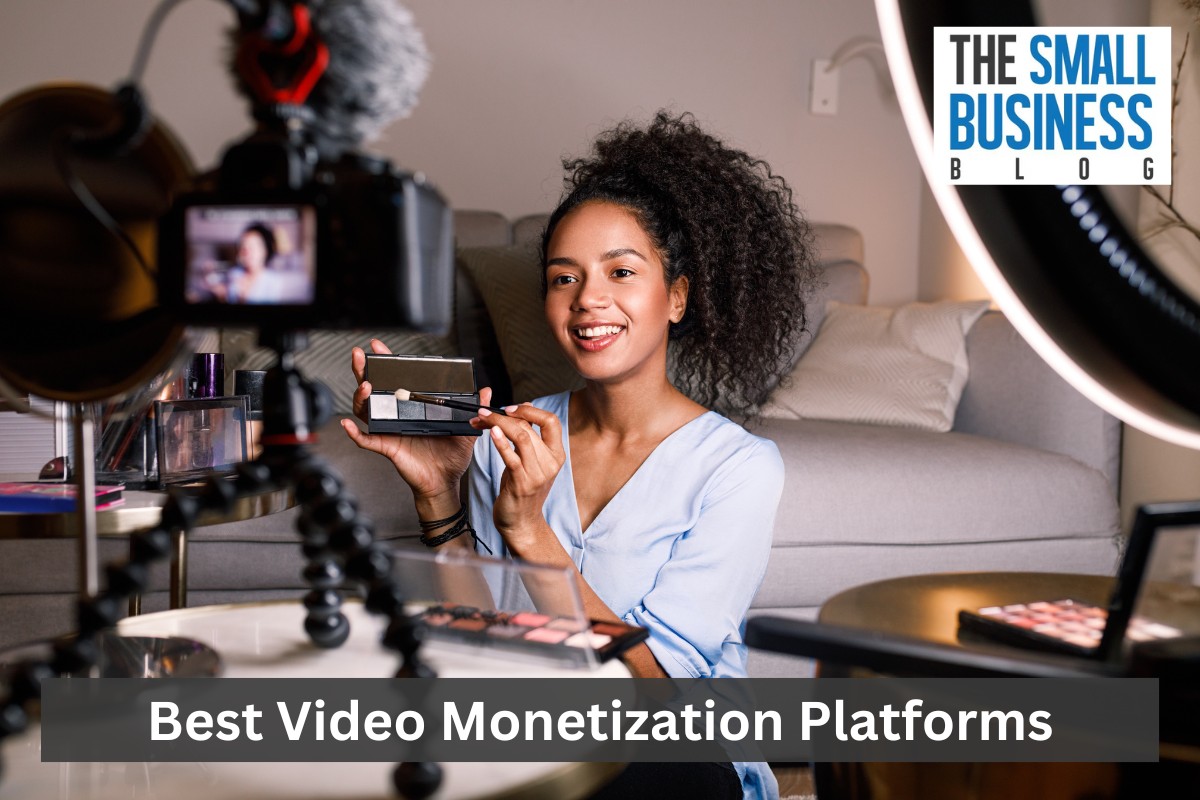Are you an aspiring content creator looking to turn your passion for videos into a profitable venture?
Video monetization has grown to offer substantial financial rewards to individuals and companies in recent years.
You can easily make money from your videos on several sites, whether you’re a vlogger, gamer, instructor, or company owner.
But where do you do that?
To help you generate money doing what you love, in this article, we will examine the top 11 best video monetization platforms and how to choose the right one.
Post Contents
11 Best Video Monetization Platforms

1. YouTube
As the leading video-sharing platform, YouTube provides many monetization options.
Aside from ad revenue, its YouTube Partner Program gives creators live-stream perks such as chats and stickers.
These in-person interactions foster deep bonds with audiences, resulting in immediate financial support.
YouTube’s algorithmic reach also facilitates content discovery, increasing the earning potential of creators.
Furthermore, the platform’s Analytics feature provides detailed insights that allow content creators to fine-tune strategies for maximum revenue generation.
Moreover, YouTube’s large user base translates to a diverse demographic, making it a veritable melting pot of monetization opportunities via merchandising, sponsored content, and crowdfunding.
2. TikTok
The monetization ecosystem of TikTok extends beyond the Creator Fund.
Its inherent virality allows creators to quickly amass large audiences, with the possibility of trending challenges resulting in global recognition.
TikTok’s authenticity attracts brands, resulting in lucrative collaborations and influencer campaigns.
The platform algorithm prioritizes content quality over follower count, levels the playing field, and rewards creativity.
Furthermore, TikTok’s diverse user base provides a fantastic opportunity for niche content creators to connect with highly targeted audiences.
Its integrated shopping features expand monetization opportunities further by directly linking products to videos, providing a seamless conversion pathway.
3. Patreon
Patreon thrives on close relationships with its patrons.
Creators can set up a subscription-based revenue model, giving supporters exclusive access to content and cultivating a sense of belonging.
Patreon creates a community around creators in addition to financial support, which leads to long-term, sustained support.
Its tiered approach allows for customization, allowing creators to tailor perks to different supporter levels.
Furthermore, Patreon’s direct communication tools enable personal interactions beyond traditional transactional dynamics.
The platform’s lack of reliance on algorithms ensures content visibility, putting monetization power squarely in the hands of creators.
4. Vimeo
“Vimeo On Demand” by Vimeo is a haven for premium content creators.
Filmmakers, educators, and businesses value the ability to monetize their videos by selling or renting them.
Its emphasis on quality over quantity appeals to audiences looking for original, curated content.
Creators retain control over pricing, rights, and distribution, giving them independence not found on other platforms.
The ad-free environment on Vimeo ensures uninterrupted viewing experiences, attracting viewers who value high-quality, ad-free content.
Membership options on the platform provide subscribers exclusive access, generating recurring revenue streams and encouraging a loyal viewer base.
5. Wistia
Wistia is a treasure trove for marketers, catering to business-oriented video content.
Businesses can use its branding customization options to create immersive video hubs seamlessly integrating into existing websites.
The detailed viewer analytics provide actionable insights, allowing data-driven content changes to improve engagement and conversion rates.
The platform’s emphasis on viewer privacy fosters trust and credibility, making it a popular choice for business-to-business communication.
Wistia’s integrations with marketing tools broaden its utility, allowing businesses to integrate video content into more significant marketing strategies seamlessly.
6. Dailymotion
Dailymotion’s monetization options include the Partner Program and the Motionmaker initiative.
Creators profit from advertisements and exclusivity via Motionmaker, encouraging a diverse range of original content.
The platform’s global audience allows creators to tap into various markets, providing unique monetization opportunities.
The emphasis on high-quality content distinguishes Dailymotion, which caters to audiences looking for an alternative to mainstream platforms.
Furthermore, its adaptable content policies entice creators to experiment with new themes and formats, broadening the horizons of monetization opportunities.
7. Twitch
Twitch’s revenue is based on live streaming and community engagement.
While ads and subscribers generate revenue, Bits offers an interactive tipping mechanism that strengthens viewer-creator bonds.
The platform’s gaming focus also allows for non-gaming content, allowing creators to diversify their revenue streams.
Twitch’s thriving community and built-in monetization tools foster an ecosystem where creators can thrive financially while cultivating loyal fan bases.
Furthermore, integrating affiliate marketing and merchandise sales supplements traditional income, allowing creators to experiment with hybrid monetization strategies.
8. Uscreen
Uscreen gives creators the ability to launch personalized subscription-based video streaming services.
Its white-label solution serves a variety of markets, including fitness, education, and entertainment.
Creators not only directly monetize their content but also benefit from the platform’s branding flexibility, reinforcing their distinct identity.
The subscription model encourages recurring revenue, which offers stability and predictability.
Uscreen’s content distribution versatility, ranging from video courses to live streaming, caters to a diverse range of creators, ensuring a diverse monetization ecosystem.
9. Kaltura
The interactive video capabilities of Kaltura cater to educators and businesses looking for dynamic monetization.
Kaltura allows creators to create immersive learning experiences besides traditional educational content sales.
Its pay-per-view model extends to live events, allowing it to maximize revenue through virtual conferences and workshops.
The open API of the platform encourages customization and integration, allowing for novel monetization solutions.
The emphasis on engagement at Kaltura ensures that creators generate revenue and deliver valuable, impactful content, fostering a long-term learning and communication ecosystem.
10. JW Player
The multifaceted approach of JW Player improves video monetization for various creators.
Its video hosting service delivers content in real-time and includes customizable branding options.
JW Player’s advanced analytics go beyond basic metrics, providing granular insights for refining monetization strategies.
Ad integrations on the platform increase revenue streams while targeting capabilities improve ad effectiveness.
JW Player’s adaptability supports various content formats, fostering engagement and viewer loyalty, critical components of successful monetization campaigns.
11. Brightcove
Brightcove’s enterprise-level video platform meets a wide range of corporate requirements.
The platform offers robust integration with other marketing tools and traditional monetization avenues such as subscription models and pay-per-view options.
This collaboration boosts audience engagement and conversion rates, closing the gap between video content and broader marketing strategies.
Brightcove’s extensive analytics enable businesses to decipher viewer behaviors and tailor content for the best monetization results.
Its scalability and security features are invaluable for companies looking for comprehensive video solutions that integrate seamlessly with their revenue generation goals.
Key Factors to Consider When Choosing a Monetization Platform

Selecting the right platform for video monetization can significantly impact your success.
Here are vital factors to consider when making your choice:
Audience Size
Understanding your target audience’s preferences and behaviors is vital.
Some platforms cater to specific niches, while others have a broader user base.
Evaluate whether your content aligns with the platform’s audience to maximize engagement.
Revenue Sharing Models
Different platforms offer various revenue-sharing models.
Many share a percentage of ad revenue, while others provide subscription-based income or pay-per-view options.
Research and compare these models to determine which suits your content and goals.
Content Types Allowed
Each platform has its guidelines on the types of content allowed.
There are platforms who are more lenient, while others have stricter policies.
Ensure your content complies with these guidelines to avoid potential conflicts and account suspension.
Tips for Maximizing Your Earnings

Monetizing your videos effectively goes beyond simply uploading content.
Here are some tips to help you maximize your earnings:
Consistent Content Creation
Consistency is critical to building a loyal audience.
Regularly upload high-quality videos to keep your viewers engaged and returning for more.
It also helps establish a predictable schedule, increasing anticipation for your content.
Interaction and Engagement
Engage with your audience to foster a strong community.
Respond to comments, hold Q&A sessions, and consider creating content based on viewer suggestions.
This interaction builds loyalty and encourages viewers to support your monetization efforts.
Analyze Performance Metrics
Regularly monitor your performance metrics to gain insights into what’s working and what’s not.
Monitor metrics like watch time, audience retention, and click-through rates.
Adjust your content strategy based on these insights to optimize your revenue generation.
Frequently Asked Questions
Can anyone start monetizing their videos?
Yes, anyone who has valuable content can begin monetizing their videos.
Many platforms have made monetization available to creators of all sizes and niches.
However, venues can have requirements you must meet to be monetized, such as engagement numbers and channel activity.
What type of content performs well on video monetization platforms?
Diverse content, such as educational tutorials, entertaining skits, insightful product reviews, and engaging vlogs, can perform exceptionally well.
The key is to provide value and resonate with your target audience.
How much can I earn through video monetization?
Earnings can vary significantly. It depends on your audience size, engagement levels, the monetization strategies you employ, and the platform’s revenue-sharing models.
Successful creators can earn anywhere from a supplemental income to substantial revenue.
Are there any risks associated with video monetization?
While video monetization can be rewarding, there are potential risks, such as copyright infringement, platform policy violations, and fluctuating ad revenue.
It’s crucial to understand and adhere to platform guidelines and legal considerations.
Conclusion
As you step into video monetization, remember that success combines dedication, consistency, and interaction.
Know your audience, create great content, and engage with your community to build that loyal following.
Looking ahead, the future of video monetization holds even more exciting prospects.
From fresh ad formats to immersive experiences, the potential is immense.
Embrace these changes, stay flexible, and share your authentic voice with the world.
So, grab the opportunities that video monetization brings, whether you’re a storyteller, a teacher, or someone with a unique perspective by working on a site from our list of the 11 best video monetization platforms.






























